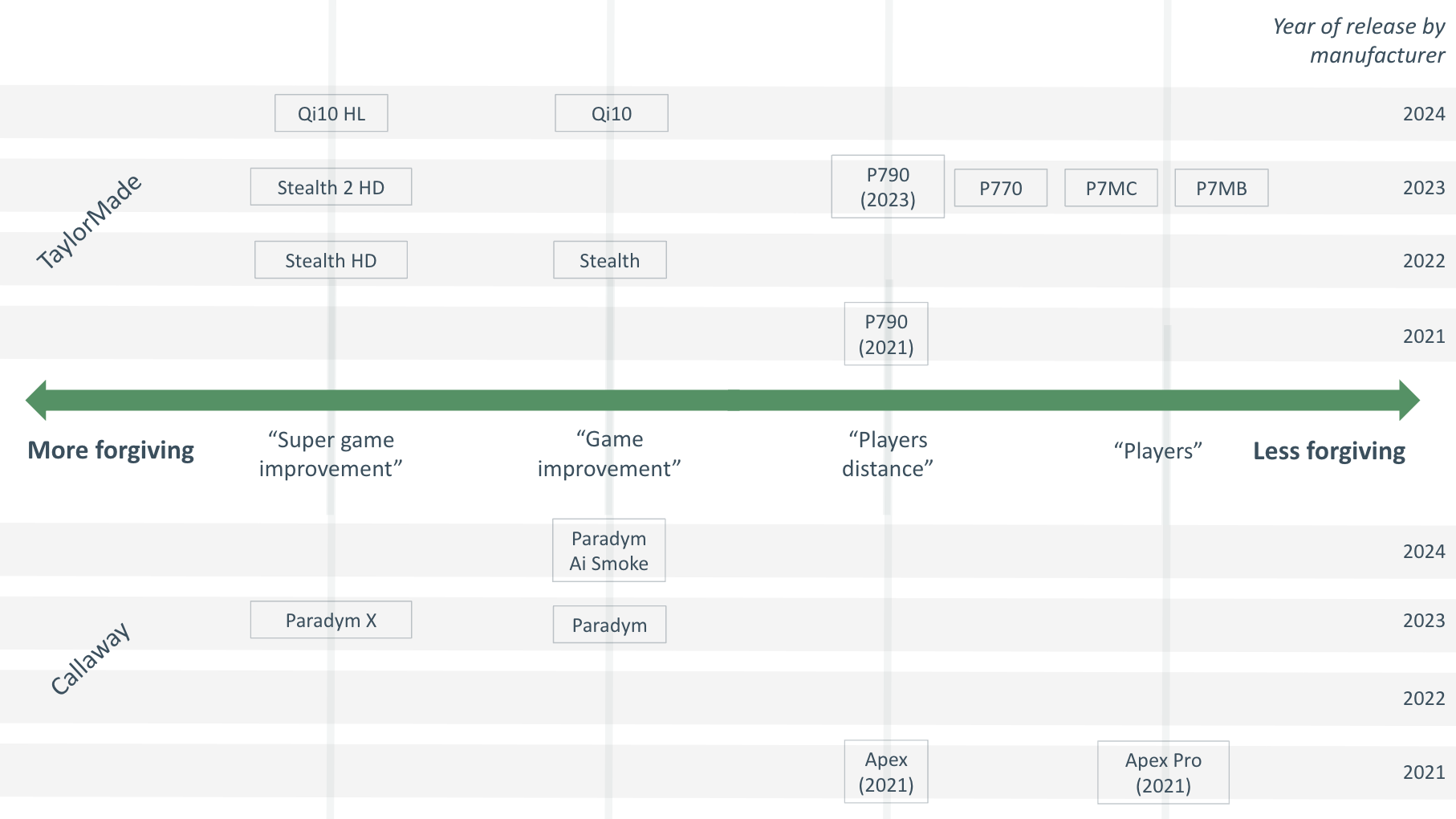Golf equipment preferences are highly subjective, and for a variety of reasons different players prefer different equipment. From time to time, even the most accomplished players in the world, for example, that has some “game improvement” qualities. On the other hand, players with less experience and less consistent ball-striking ability might sometimes enjoy experimenting with gear designed with expert-level swings in mind.
With this caveat out of the way, we provide this visual guide to the various iron models in our product offering. This graphic represents our assessment of the models’ respective “levels of forgiveness”:
Available iron models and their “levels of forgiveness”

By “forgiveness,” here, we mean that from shot to shot a more forgiving club will tend to feel (to the player) more similar and perform (based on the behavior of the ball) more similarly with variations in the way the clubhead impacts the ball, and a less forgiving club will tend to feel more different and perform more differently with such variations.
For a player who is primarily interested in hitting the ball straight, such variations may be undesirable, while for a player who would like to “shape” shots or get more feedback from the club about the quality of impact, such variations may be desirable.
Broadly speaking, as iron models move toward the more forgiving end of this spectrum, the sole of the club will tend to widen, the “topline” will tend to thicken, and designs will aim to reduce sidespin and to help the ball get airborne. According to conventional wisdom in the industry, these clubs will be easier to hit, but we think that this assessment is ultimately yours to make. Those features will tend to reverse as iron models move toward the “players” end of the spectrum and, also according to the conventional wisdom, these clubs will tend to be more difficult to hit.
Convention wisdom, continued: A direct tradeoff exists between shotmaking potential and forgiveness. The more forgiving an iron gets, the thinking goes, the more difficult it becomes for the player to tinker with the spin and trajectory of the ball; on the other hand, the less forgiving an iron gets, the easier it becomes to “work” the ball from left-to-right or right-to-left, to send it high, or to flight it low.
Please note that while in certain cases model names of metalwoods that we carry might be identical to the model names of the irons in this chart, we intend for the assessment above to only account for irons. Preferences toward certain metalwoods may be even more varied than preferences toward certain irons. For players considering renting just irons or full sets, we think that this irons-specific orientation may be a helpful starting point, because we consider the iron set to be the “nucleus” of the full set.
Resources like Golf Digest’s “Hot List” and like this forum on GolfWRX can provide additional orientation.
Callaway irons
| Relevant products on Clublender.com | More information from Callaway |
|---|---|
| Apex 21, Apex Pro 21, and Apex DCB 21 | Apex 21, Apex Pro 21, and Apex DCB 21 |
| Big Bertha B21 and Big Bertha Reva | Big Bertha B21 and Big Bertha Reva |
| Mavrik | Mavrik |
TaylorMade irons
| Relevant products on Clublender.com | More information from TaylorMade |
|---|---|
| P790 and P770 | P790 and P770 |
| SIM2 Max | SIM2 Max variations |
| SIM Max |
Please note that you can find additional product information at any product page on Clublender.com by following any of the links in the lefthand column of the table above and then selecting a specific product.
